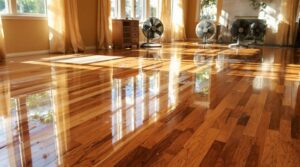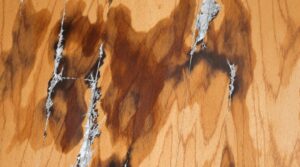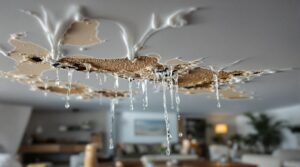Cupped wood floors can flatten naturally if the underlying moisture issues are resolved promptly. Recovery depends on several factors, including moisture exposure duration, wood type, and environmental conditions. Mild cupping often resolves within weeks when proper humidity levels are maintained between 30-50%. Severe cases may require professional intervention, especially if the damage is extensive or persistent. Understanding the specific causes and recovery timeline helps property owners determine the most effective restoration approach.
Key Takeaways
- Natural cupping from routine humidity fluctuations typically flattens within weeks when moisture levels return to normal.
- Mild cupping under 2mm height differential has better chances of flattening naturally than severe cases over 4mm.
- Recovery depends on exposure duration, wood type, and climate conditions, with solid hardwood showing better recovery potential.
- Proper humidity control between 30-50% and addressing moisture sources are essential for successful flattening.
- Permanent cupping from prolonged moisture exposure may require professional intervention and won't flatten naturally.
Understanding Wood Floor Cupping: Signs and Symptoms
The phenomenon of wood floor cupping manifests through distinct visual and physical changes in floorboards. The primary indicator is a concave shape where the edges rise higher than the center of each plank, creating an uneven surface that reflects light irregularly.
This distortion becomes particularly visible when viewed from a low angle, revealing a characteristic bowing effect across the boards. A reliable wood moisture meter can help assess moisture levels and determine the severity of cupping issues.
Early detection of cupping causes involves identifying subtle changes, including slight shadows along board edges and minimal elevation variations. Regular inspection plays an essential role in moisture management and preventing severe damage.
Advanced stages may exhibit gaps between boards, persistent condensation on surfaces, and musty odors indicating underlying moisture issues. Professional assessment becomes vital when these symptoms progress, as proper intervention can prevent costly repairs and restore floor integrity.
Common Causes of Cupped Hardwood Floors
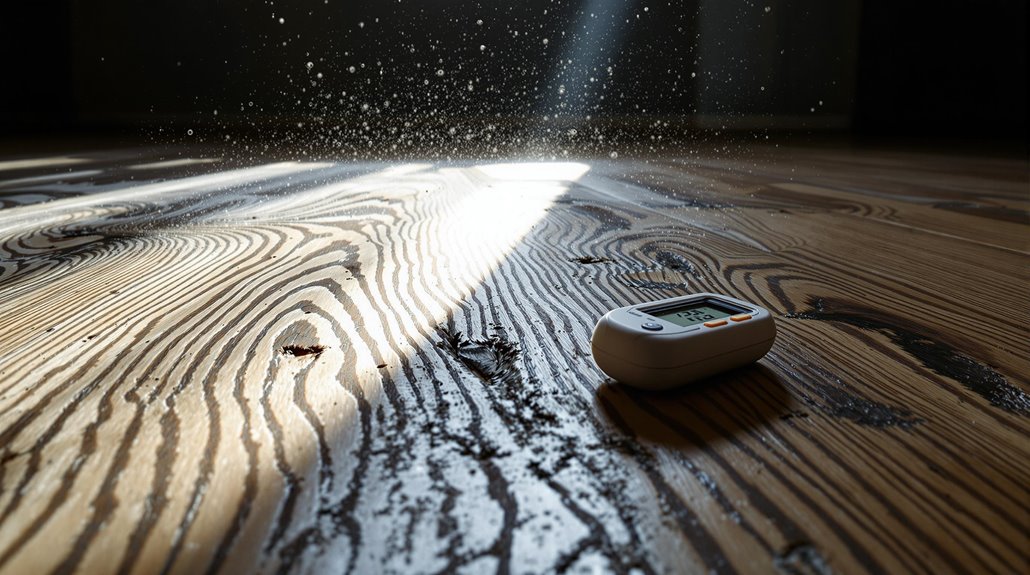
Moisture-related issues represent the primary catalyst for hardwood floor cupping, encompassing both environmental factors and installation-related challenges.
Multiple moisture sources can trigger cupping, including subfloor dampness, concrete slab emissions, and elevated humidity levels in basements or crawl spaces.
Installation techniques greatly influence a floor's susceptibility to cupping.
Both solid and engineered hardwood flooring can experience cupping when exposed to moisture over time.
Inadequate acclimation periods, improper subfloor preparation, and failing to achieve equilibrium moisture content before installation can create conditions favorable for cupping.
Environmental factors, such as seasonal humidity fluctuations and poor ventilation, further compound these issues.
Maintenance practices also play a vital role, as water-based cleaners and unaddressed spills can introduce excess moisture.
Regular monitoring with a wood moisture meter and prompt attention to leaks are essential for preventing and identifying cupping issues early.
Natural vs. Permanent Floor Cupping
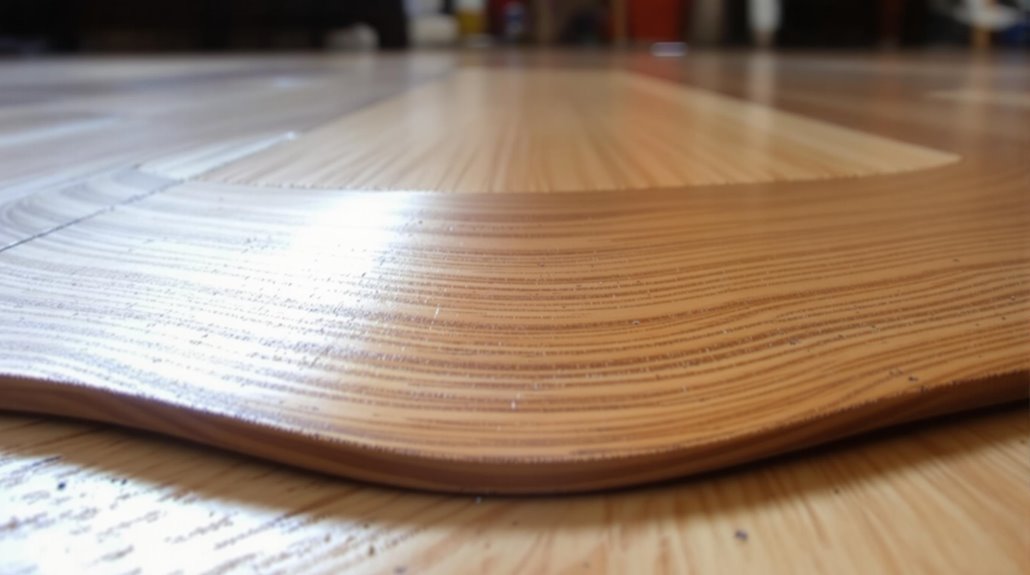
Wood floor cupping manifests in two distinct forms: natural cupping, which occurs from routine humidity fluctuations and typically self-corrects, and permanent cupping, which results from prolonged moisture exposure and requires professional intervention.
The recovery timeline for cupped floors depends on several factors, including the severity of moisture exposure, environmental conditions, and the wood's specific characteristics. Using a moisture meter regularly helps monitor the drying process and predict recovery outcomes.
While natural cupping often resolves within weeks as moisture levels normalize, permanent cupping may persist even after drying, necessitating floor replacement when the wood's cellular structure has been compromised.
Types of Floor Cupping
Floor cupping manifests in two distinct forms: natural and permanent deformation.
Natural cupping is characterized by temporary concave distortion where board edges rise above their centers due to short-term moisture exposure. This type is typically reversible when environmental conditions stabilize. The cupping effects are often manageable through moisture control and proper drying techniques.
Permanent cupping, however, represents irreversible damage resulting from prolonged moisture exposure. This severe condition occurs when wood fibers break down and lose their ability to return to their original shape.
Unlike natural cupping types, permanent deformation requires board replacement, as the structural integrity of the wood has been compromised. The distinction between these forms is essential for determining appropriate restoration methods and preventing further damage to the flooring system.
Recovery Timeline Factors
When evaluating recovery timelines for cupped wood floors, several critical factors determine whether natural restoration is possible or if permanent damage has occurred. The extent of moisture exposure, wood type, and local climate conditions greatly influence recovery duration.
Solid hardwood floors typically demonstrate better natural recovery potential compared to engineered varieties, particularly when proper humidity control measures are implemented.
Recovery periods can range from weeks to months, depending on the severity of cupping and environmental conditions. Effective moisture monitoring throughout the process is essential to track progress and prevent further damage.
Success rates are highest when moisture sources are promptly identified and addressed, combined with consistent temperature maintenance and adequate ventilation.
Professional assessment may be necessary for severe cases to determine the most appropriate recovery strategy.
Assessing Your Floor's Recovery Potential
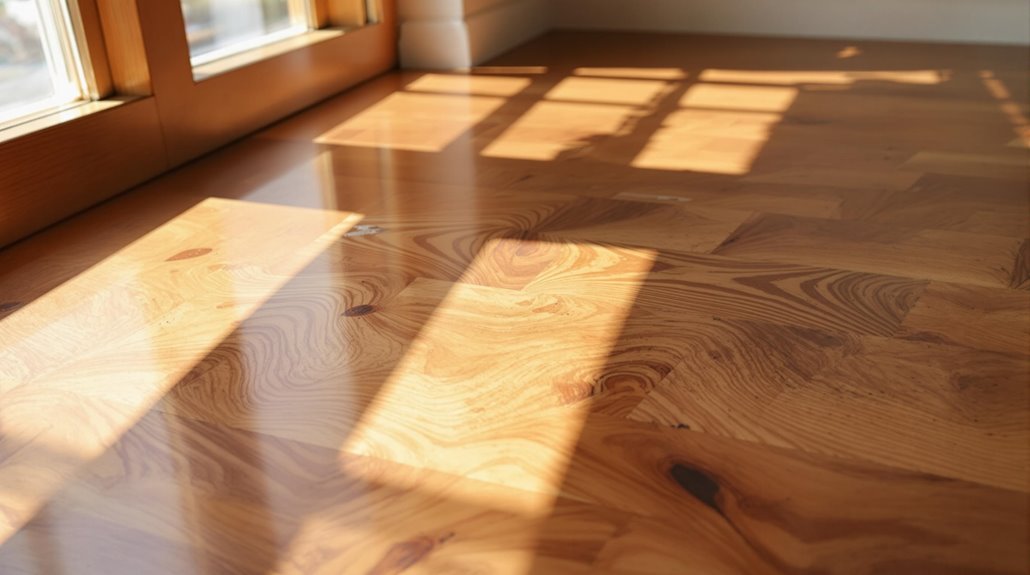
The assessment of wood floor recovery potential begins with determining the severity and duration of moisture exposure through precise moisture content measurements.
Professional evaluation using moisture meters can identify the extent of water penetration and potential long-term structural impacts on the flooring material.
The duration of moisture exposure greatly influences recovery outcomes, with prolonged exposure often requiring more intensive restoration methods compared to brief moisture events.
Damage Severity Assessment
Evaluating wood floor cupping severity requires a systematic examination of multiple factors to determine recovery potential. A thorough cupping diagnosis begins with measuring the height differential between board edges and centers, with variations under 2mm typically classified as mild and those exceeding 4mm considered severe.
Moisture analysis using specialized equipment helps identify the source and extent of water exposure.
Visual indicators such as gapping between boards, warping, and buckling provide critical data points in evaluating damage levels. The floor's composition – whether solid hardwood or engineered – affects its recovery capabilities, as does its age and maintenance history.
Professional evaluators consider these elements alongside environmental factors, including humidity levels, seasonal changes, and previous water exposure, to determine if natural recovery is possible or if restoration intervention is necessary.
Moisture Duration Impact
Understanding moisture duration impact serves as a critical factor in determining wood floor recovery potential. The length of exposure to moisture sources greatly influences whether cupped floors can return to their original state.
Short-term exposure from spills typically allows for successful recovery when addressed promptly, while long-term exposure often results in permanent damage.
- Short-term exposure (hours to days): Quick removal of moisture and proper drying techniques can lead to natural flattening.
- Seasonal exposure (weeks to months): Environmental control and humidity management can minimize cupping effects.
- Long-term exposure (months or longer): Often requires professional intervention or board replacement due to irreversible damage.
The recovery timeline varies based on exposure duration, with successful outcomes heavily dependent on swift moisture source elimination and controlled drying conditions.
Steps to Help Your Floor Flatten Naturally
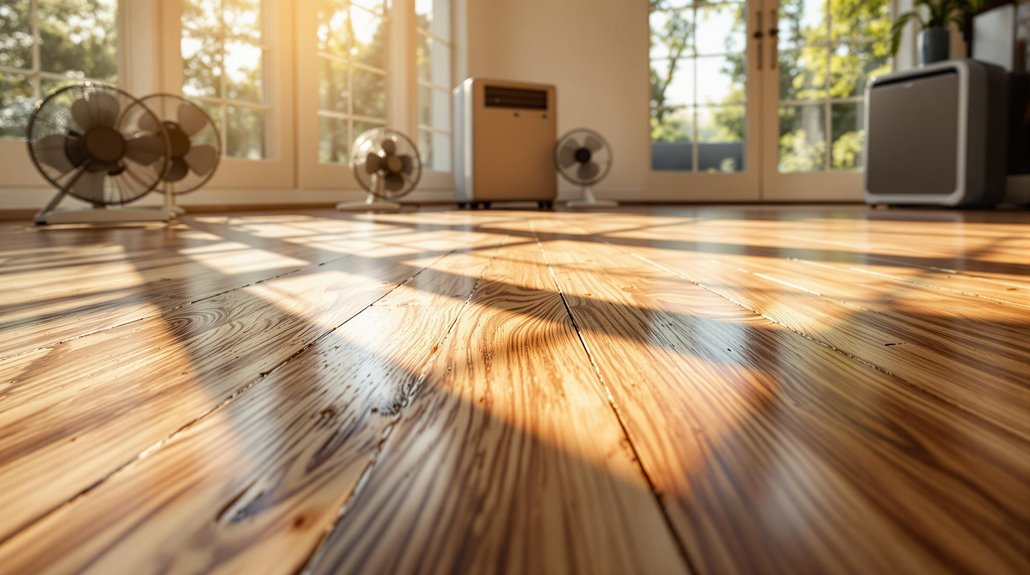
When hardwood floors develop cupping issues, implementing a systematic approach to natural flattening can restore their original shape without resorting to immediate sanding.
The process begins with accurate moisture management using a reliable wood moisture meter to identify problem areas and determine the source of excess moisture.
Essential steps include controlling environmental conditions through dehumidification, improving ventilation, and addressing subfloor moisture issues with proper vapor barriers.
Effective flooring maintenance requires consistent humidity levels and enhanced airflow using strategically placed fans.
Professionals emphasize avoiding premature sanding, as this can lead to crowning once the wood dries completely.
The natural flattening process demands patience, often taking several days to weeks depending on severity.
Regular inspection of high-risk areas and proper cleaning methods help prevent future cupping incidents.
When Professional Intervention Is Necessary
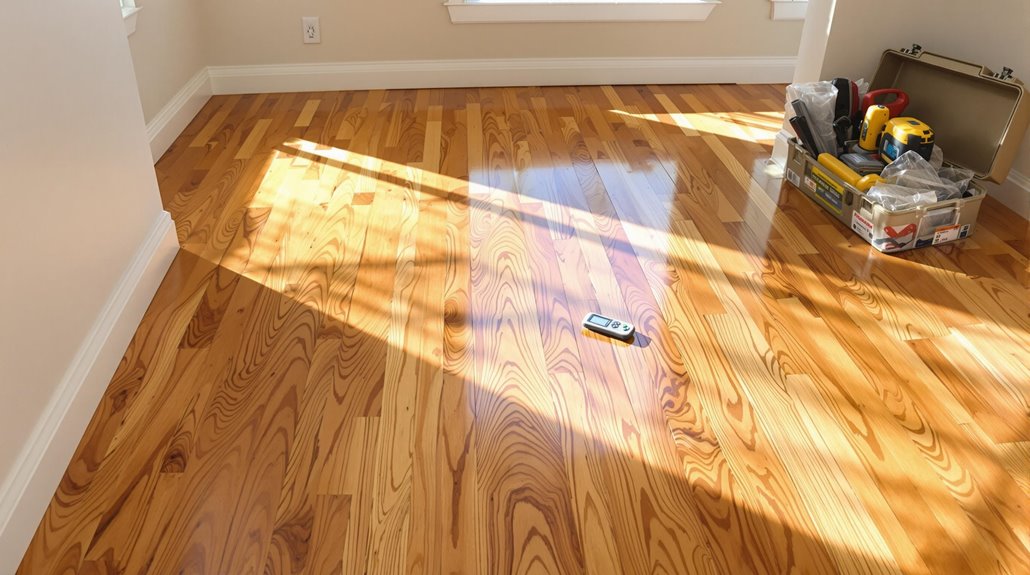
Professional hardwood floor restoration becomes vital when specific indicators signal that DIY solutions are no longer sufficient to address cupping issues.
A professional assessment becomes important when extensive warping affects large portions of the floor or when cupping persists despite moisture control efforts.
Key situations requiring expert intervention include:
- Visible structural problems, including foundation settling or prolonged dampness affecting the subfloor.
- Recurring seasonal cupping that returns despite preventive measures.
- Large-scale moisture issues requiring industrial dehumidification or vapor barrier installation.
Professionals utilize specialized tools like moisture meters and advanced sanding equipment to diagnose and address underlying causes.
Their expertise guarantees cost-effective, long-term solutions that protect both the floor's structural integrity and aesthetic value, preventing more extensive damage that could result from delayed intervention.
Long-Term Prevention Strategies
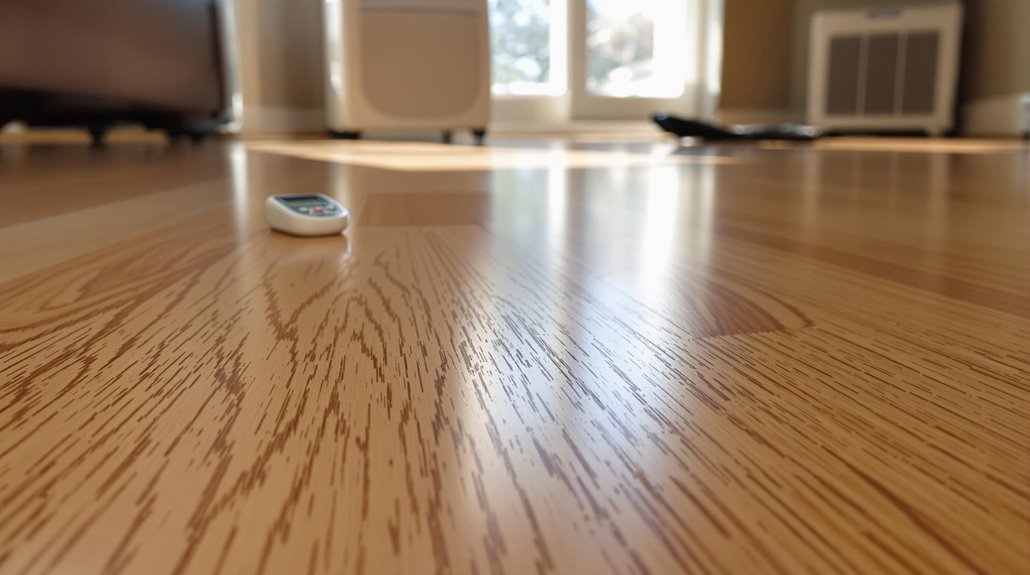
Implementing extensive prevention strategies is essential for maintaining the long-term stability of hardwood floors and avoiding cupping issues.
The foundation of prevention lies in effective humidity control, maintaining levels between 30% and 50% through proper use of humidifiers, dehumidifiers, and air conditioning systems.
Professional installation practices play a significant role, including the use of appropriate moisture barriers and thorough subfloor moisture testing.
Regular maintenance requires immediate attention to spills and the use of proper cleaning products specifically designed for hardwood floors.
Building owners must actively monitor and address potential moisture sources, such as plumbing leaks or inadequate ventilation.
Using moisture meters helps identify problem areas before they develop into significant issues, while proper sealing and vapor barriers provide additional protection against moisture infiltration from below.
The Benefits Of Consulting A Public Adjuster
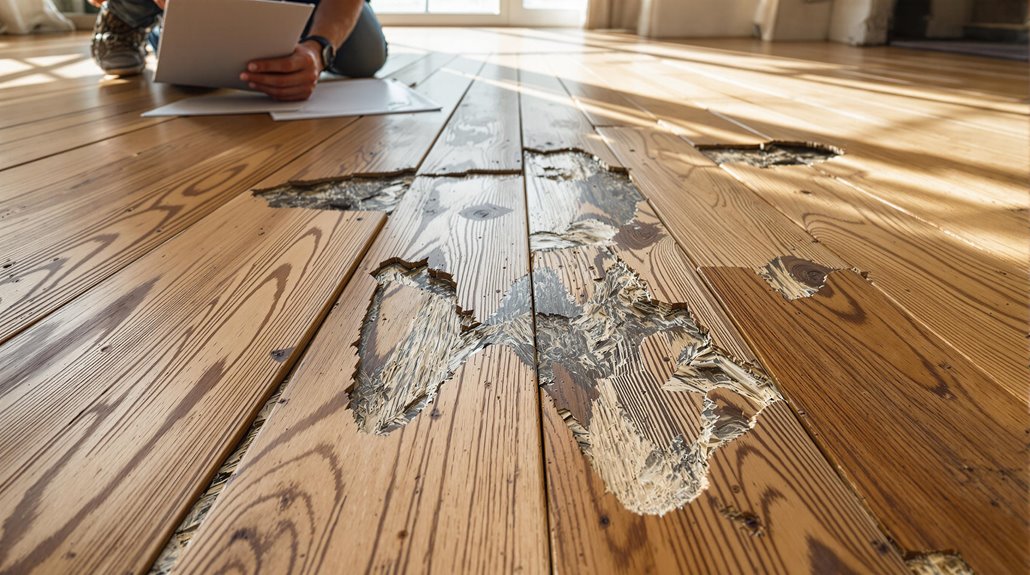
When dealing with cupped wood floor damage, a public adjuster provides expert guidance through complex insurance claims while conducting thorough, objective assessments of the affected areas.
Their specialized knowledge of policy coverage and industry standards helps streamline the claims process, reducing administrative burden on property owners.
Public adjusters typically secure higher claim settlements compared to self-filed claims, ensuring proper compensation for both visible damage and potential long-term implications of wood floor cupping.
Studies have shown that property owners who work with licensed public adjusters can receive settlements up to 500% higher than those who handle non-catastrophe claims on their own.
Expertise In Insurance Claims
Maneuvering insurance claims for cupped wood floors requires specialized expertise that public adjusters provide through their thorough understanding of policies, procedures, and industry practices.
Their extensive knowledge enables efficient navigation of the claims process, ensuring policyholders receive fair compensation for damaged flooring.
Public adjusters deliver value through:
- Detailed documentation preparation, including detailed damage assessments and accurate proof of loss statements
- Strategic insurance negotiations, leveraging their understanding of claim values and industry standards
- Professional communication management with insurance carriers, ensuring all deadlines are met while maintaining objectivity throughout the process
This expertise proves particularly valuable in wood flooring claims, where proper documentation of moisture-related damage and understanding of restoration costs are essential for achieving ideal settlements.
Working with public adjusters can result in higher claim payouts compared to handling insurance claims independently, typically charging only 5-20% of the final settlement amount.
Objective Damage Assessment
Thorough damage assessment by public adjusters provides property owners with an unbiased evaluation of cupped wood flooring conditions, ensuring accurate claim documentation and appropriate compensation.
Professional adjusters employ specialized tools, including moisture meters and assessment equipment like Wagner Meters Orion, to precisely measure moisture content and document the extent of damage.
The damage assessment process involves identifying visible signs of cupping, determining moisture sources, and evaluating whether the issue stems from localized problems or widespread environmental factors.
Adjusters systematically analyze subfloor conditions, ventilation systems, and potential leak sources while documenting all findings.
This exhaustive evaluation helps determine the most effective repair strategy, whether through dehumidification, improved ventilation, or complete wood flooring replacement, while substantiating insurance claims with detailed evidence.
With settlement outcomes typically higher when utilizing public adjusters, property owners often recover more comprehensive compensation for their damaged wood floors.
Streamlined Claim Process
Public adjusters greatly streamline the insurance claims process for cupped wood flooring by implementing automated systems and digital documentation protocols. Their expertise enhances claim efficiency through standardized procedures and real-time updates, considerably reducing processing delays and administrative burdens.
- Digital documentation eliminates manual paperwork, allowing for faster compilation and submission of evidence related to wood floor damage.
- Automated workflows enable transparent communication between all parties, building customer trust through consistent status updates.
- Online portals provide immediate access to claim documentation, empowering property owners to track progress independently.
This streamlined approach reduces operational costs while ensuring accurate damage assessment and fair compensation.
Property owners benefit from expedited claim resolution and reduced administrative requirements, allowing them to focus on floor restoration efforts.
Unlike insurance adjusters who represent companies, public adjuster advocates work exclusively for policyholders to maximize settlement amounts for damaged flooring claims.
Higher Claim Payouts & Settlements
Insurance professionals who specialize in public adjusting consistently secure higher claim payouts and settlements for cupped wood flooring damage. Their expertise in claim negotiation enables them to identify all potential damages, including those that might be overlooked during standard assessments.
Public adjusters understand complex policy language and leverage this knowledge during settlement maximization efforts. These specialists employ proven negotiation techniques to counter insurance companies' strategies that may minimize payouts.
While they typically charge up to 10% of the total settlement, their involvement often results in substantially higher compensation that offsets their fees. Their thorough documentation processes, combined with deep understanding of local regulations and industry practices, provide leverage in achieving ideal claim outcomes.
This expertise proves particularly valuable in complex cases involving extensive wood floor damage.
With less than 5% of policyholders being aware of public adjusters' services, many property owners miss opportunities for maximized settlements.
About The Public Claims Adjusters Network (PCAN)
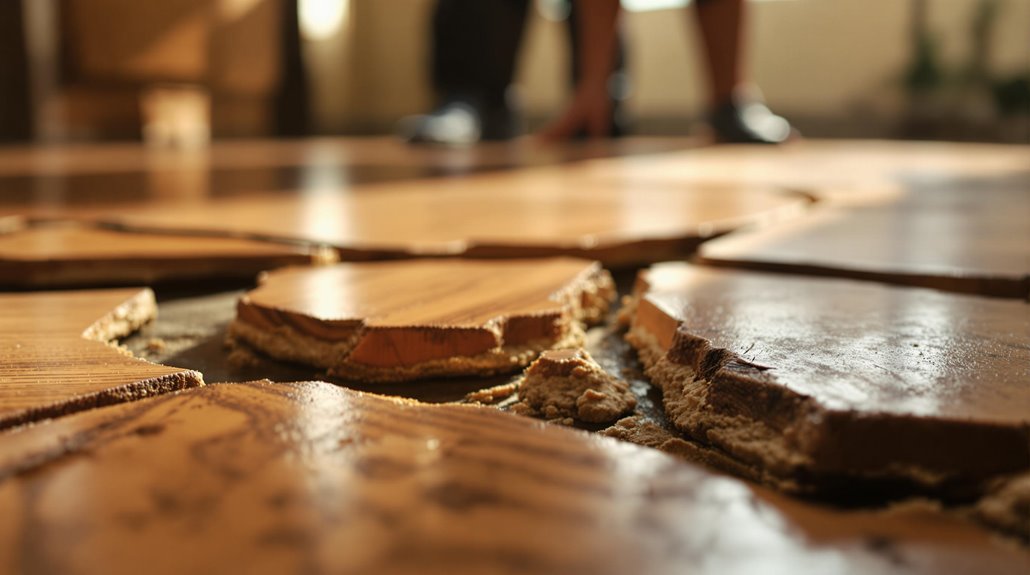
When property owners face complex insurance claims, the Public Claims Adjusters Network (PCAN) serves as a thorough resource connecting clients with certified professionals who specialize in maximizing claim settlements.
The network's extensive approach delivers significant Public Adjuster Benefits through:
- Immediate access to state-certified adjusters who work on a contingency basis, eliminating upfront costs.
- Professional support throughout the Claims Process, including initial filing, negotiations, and resolution of denied claims.
- Call center assistance and customized solutions tailored to each property owner's unique situation.
PCAN's team of experienced adjusters maintains a proven track record of increasing claim payouts by an average of 747%, according to government studies.
Their professional expertise and established relationships with insurance companies guarantee efficient claim handling and favorable outcomes for property owners.
Frequently Asked Questions
How Long Should I Wait Before Refinishing My Cupped Floor?
Like waiting for a smartphone to update, patience is essential. After cupping causes resolve and moisture levels normalize, homeowners should wait 2-3 months before proceeding with flooring maintenance refinishing.
Can I Speed up the Flattening Process by Adding Weight?
Adding weight to speed up flattening is not recommended as it risks structural damage. Proper moisture control through dehumidifiers and ventilation remains the safe, effective approach for natural recovery.
Will Insurance Cover the Cost of Fixing My Cupped Floors?
Insurance policies typically cover water-damaged cupped floors if caused by covered perils. Coverage limits and specific policy terms determine repair or replacement compensation. Professional assessment is required for claim approval.
Should I Remove Furniture While Waiting for Floors to Flatten?
Removing furniture enables ideal moisture control and uniform flattening. The clear space promotes even drying and allows proper inspection. Strategic furniture placement after drying helps prevent future cupping issues.
Can Specific Types of Wood Flooring Be More Resistant to Cupping?
Like warriors against moisture, engineered hardwoods, particularly oak and maple, demonstrate superior cupping resistance. Bamboo's dimensional stability and modern manufacturing techniques also make it exceptionally resilient to moisture-related deformation.
References
- https://www.wagnermeters.com/moisture-meters/wood-info/can-wood-floor-cupping-be-fixed/
- https://www.fromtheforest.com/blogs/fromtheforest/floor-cupping-what-you-need-to-know
- https://www.wagnermeters.com/moisture-meters/wood-info/spotting-trouble-hardwood-floors/
- https://www.woodfloorbusiness.com/installation/moisture/article/15128833/wood-floor-cupping-why-does-it-happen-what-can-you-do
- https://www.floortrendsmag.com/articles/110976-how-to-remediate-a-cupped-wood-floor
- https://www.firstatlantaflooring.com/news/hardwood-floor-cupping-what-is-it-and-how-can-you-fix-it/
- https://infinityfloorssussex.com/wood/understanding-wood-floor-cupping/
- https://artisanwoodfloorsllc.com/hardwood-flooring-blog/what-is-cupping-in-hardwood-floors-causes-prevention-and-solutions/
- https://blog.cityfloorsupply.com/how-to-fix-hardwood-floor-problems-cupping-crowning-chatter/
- https://www.builddirect.com/blogs/expert-advice-on-flooring/what-is-peaking-buckling-and-cupping-in-wood-floors
